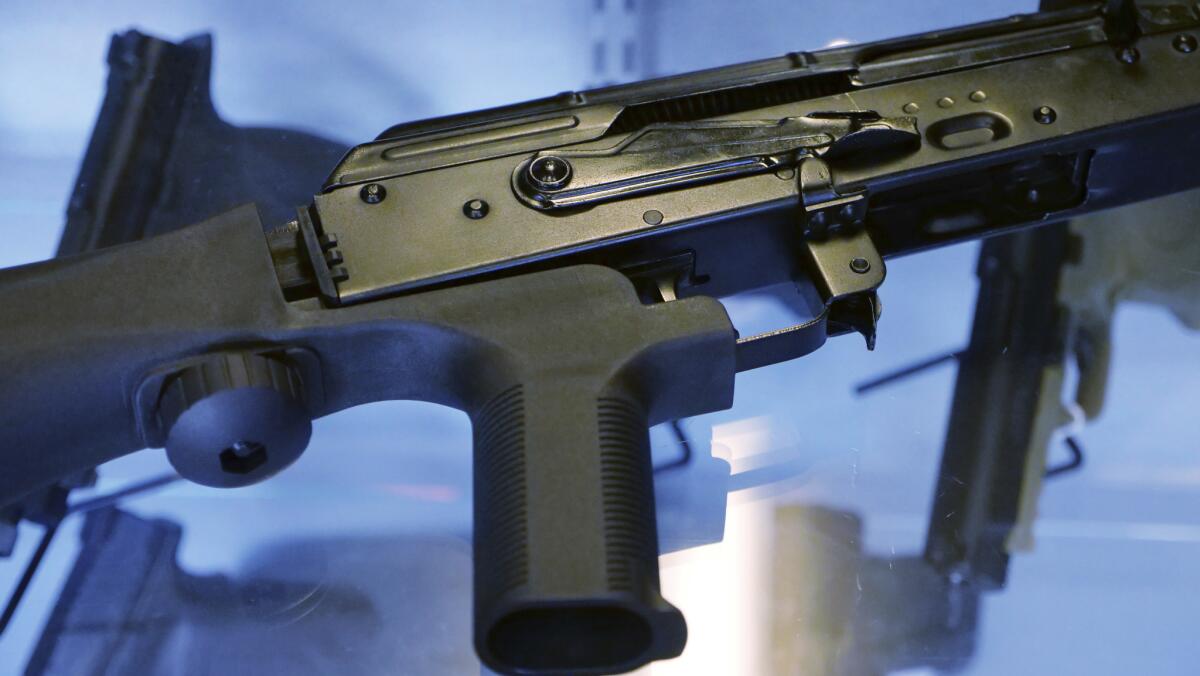Editorial: The gun industry’s drive to circumvent gun laws helped make the Las Vegas massacre worse

- Share via
The non-gun-lovers among us — and maybe even a few gunlovers — have learned a couple of new terms over the last few days: “bump stock” and “trigger crank.” Without getting into the technical details, they are devices designed to let shooters fire semiautomatic rifles, which are generally legal to own, as though they were automatic rifles — machine guns — which generally are not legal to own. In other words, the bump stock, trigger crank and similar pieces of equipment dodge federal gun laws intended to keep most people from getting their hands on guns that fire bullets continuously and rapidly with a single pull of the trigger.
It was the use of bump stocks, officials say, that enabled Stephen Paddock to inflict so much damage so quickly from a 32nd-floor hotel room in Las Vegas on Sunday. It’s outrageous that such devices are legally bought without so much as a background check, and for as little as $100. Sen. Dianne Feinstein (D-Calif.) and fellow members of the Senate have introduced the Automatic Gunfire Prevention Act, which would ban the sale of any accessory or device that is “designed or functions to accelerate the rate of fire of a semiautomatic rifle.”
Feinstein has pushed this issue before, to no avail. But this time — in the wake of the carnage in Las Vegas — some Republican congressional leaders seem to recognize that such after-market devices make a mockery of existing gun-control laws and say they would consider banning them, and even the usually unyielding NRA said Thursday the government should review whether they are legal. To show they’re serious, the gun lobby and its minions in Congress should back Feinstein’s proposal. We also hope they back a measure by Rep. Adam Schiff (D-Burbank) and Senator Richard Blumenthal (D-Conn.) to repeal the 2005 Protection of Lawful Commerce in Arms Act, which protects manufacturers, distributors and dealers of firearm and ammunition products — not just guns and bullets, but lethal accessories such as bump stocks and trigger cranks — from liability lawsuits by victims and their survivors. That was an astounding and, as the nation has seen, dangerous gift to the gun industry.
The grating thing, though, is that no matter what Congress or state legislatures do by law, and no matter what the Bureau of Alcohol, Tobacco, Firearms and Explosives does by regulation, the firearm industry seeks new and ever more innovative ways to cheat. Consider the case of bump stocks. At the moment, continuous-fire automatic weapons are largely banned. Legal semiautomatic firearms, by contrast, can fire bullets only as fast as the shooter can pull the trigger, usually about three times a second.
A bump stock replaces the grip and original gun stock on a semiautomatic weapon, locks the shooter’s finger in place, and uses energy from the weapon’s recoil to slide the trigger back and forth, accelerating how fast the trigger gets pulled. The Las Vegas shooter fired 98 shots in ten seconds, by one count, about as close to automatic fire as you can mimic.
Remarkably, such devices are legal, the ATF ruled in 2010, because “the stock has no automatically functioning mechanical parts and performs no automated mechanical functions when installed.” So the device doesn’t fundamentally change how the rifle works. It just makes it work faster. The crank similarly lets the shooter spin a crank that then presses the trigger much faster than he would otherwise be able to.
There is no reason for using such a mechanism other than to circumvent the ban on automatic weapons. We saw a similar adaptation with the “bullet button.” California requires that a semiautomatic rifle be equipped with a fixed magazine that requires a tool for its removal. So, gadget makers in the gun industry developed a locking mechanism for the magazine that can be undone simply by pressing a recessed release button — using, for instance, the tip of a bullet. The change subverts the intent of the law, which was to prevent mass shooters from reloading quickly. Voters approved Proposition 63 last year to ban bullet buttons, but gun rights groups have challenged the measure.
The cleanest solution would be to ban semiautomatic guns entirely, but that’s not likely to happen given who controls the White House and Congress. This isn’t about deterring hunting, or self-defense, or sport shooting, or even fighting off tyranny. It’s about taking away the tools of mass murderers.
Follow the Opinion section on Twitter @latimesopinion or Facebook
UPDATES:
12:05 p.m.: This editorial was updated to include the NRA statement on reconsidering the legality of bump stocks.
10:50 a.m.: This editorial was updated with information about proposed legislation.
Originally published at 4 a.m.
More to Read
A cure for the common opinion
Get thought-provoking perspectives with our weekly newsletter.
You may occasionally receive promotional content from the Los Angeles Times.










